Michael Finocchiaro's Blog
October 3, 2024
Gothic Grandeur: The Role of Monasteries in the Evolution of Medieval Architecture
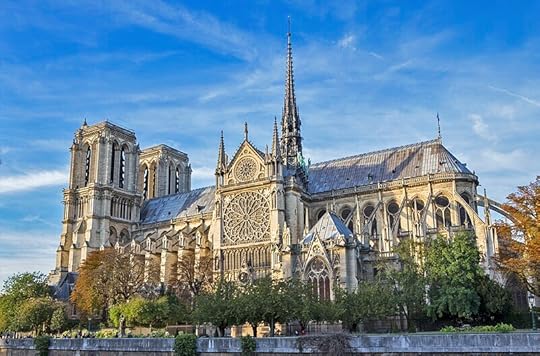 Introduction
IntroductionThe Gothic era of architecture, which flourished between the 12th and 16th centuries, marked a transformative period in European history. Characterized by towering cathedrals, pointed arches, ribbed vaults, and flying buttresses, Gothic architecture was not just an expression of structural ingenuity but also a reflection of deep spiritual values. While the Church was the dominant patron of Gothic structures, monastic orders played a pivotal role in shaping the aesthetic and philosophical foundations of these magnificent buildings. This article explores the influence of these monastic communities, particularly the Cistercians, on the evolution of Gothic architecture and how their spiritual practices fostered some of the most awe-inspiring works of medieval art.
The Origins and Defining Features of Gothic ArchitectureGothic architecture emerged in the mid-12th century in France, a product of social, religious, and technological advancements. The style was primarily designed to inspire awe and elevate the soul, a physical manifestation of the medieval desire to connect with the divine. The soaring heights of Gothic cathedrals, coupled with the extensive use of stained glass windows, allowed for a flood of natural light to penetrate the sacred spaces, symbolizing the presence of God.
Key features that defined Gothic architecture include:
Pointed Arches: Unlike the round arches of Romanesque architecture, pointed arches provided better weight distribution and allowed for taller, more expansive structures.Ribbed Vaults: Ribbed vaulting strengthened the ceilings of Gothic churches, allowing them to span larger areas while reducing the load on walls.Flying Buttresses: These external supports allowed architects to build higher walls and insert large stained glass windows, dramatically changing the appearance of church interiors by flooding them with colored light.Stained Glass Windows: These windows were more than decorative elements; they were used to depict biblical scenes and saints, serving as a visual form of theological instruction for the largely illiterate population.While these architectural advancements were essential to the rise of Gothic cathedrals, the spiritual philosophy behind them was deeply influenced by monastic orders that prioritized simplicity, contemplation, and humility.
Monastic Orders and Their Influence on Gothic Austerity: The Cistercian ExampleAmong the various religious orders that shaped the cultural and spiritual life of medieval Europe, the Cistercians stand out for their direct influence on Gothic architecture. Founded in 1098 by Saint Robert of Molesme, the Cistercian order was born as a reaction to what its founders saw as the growing worldliness of Benedictine monasticism. They sought a return to a stricter interpretation of the Rule of Saint Benedict, emphasizing simplicity, manual labor, and poverty.
This commitment to simplicity and austerity had a profound impact on Gothic architecture. While the broader Gothic movement embraced grandeur, light, and intricate ornamentation, Cistercian architecture was known for its stark, minimalist designs. Cistercian abbeys avoided excessive decoration, preferring unadorned stonework and clear, functional lines. This aesthetic choice reflected their spiritual values, focusing on contemplation and humility over material excess.
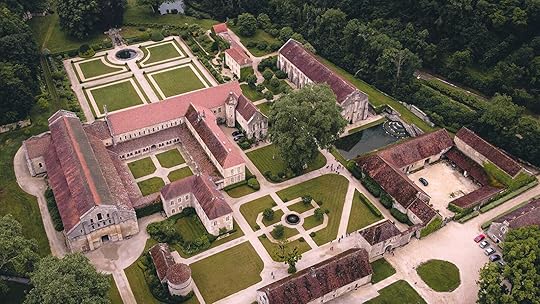
For example, Fontenay Abbey, founded in 1118 and built in the early Gothic style, exemplifies the Cistercian commitment to simplicity. Its austere stone walls, lack of elaborate decoration, and reliance on natural light create an atmosphere of serenity and reflection, in line with the order’s desire for a pure, distraction-free worship environment.
While the Cistercians eschewed the decorative flamboyance of their counterparts, their architectural principles directly influenced the broader Gothic movement. Their focus on structural clarity and light influenced the designs of some of the most iconic Gothic cathedrals in Europe.
Case Studies: Key Gothic Structures and Monastic Influence1. Chartres Cathedral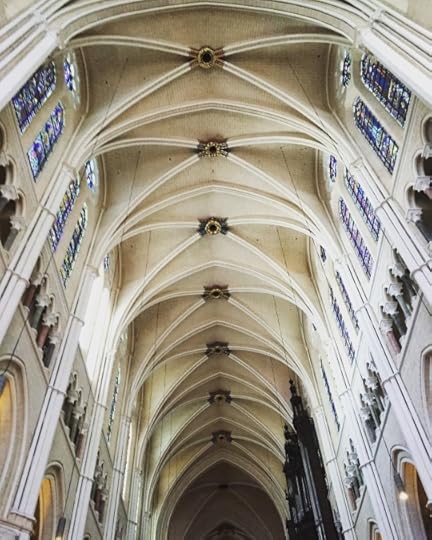
Chartres Cathedral, located in northern France, stands as one of the most significant achievements of Gothic architecture, with its construction beginning in 1194. Although not directly tied to a specific monastic order, the spiritual principles shared by monastic communities—particularly the focus on divine light—are evident in its design. Chartres is known for its towering spires, flying buttresses, and, most notably, its magnificent stained glass windows, which bathe the interior in a kaleidoscope of colors, creating an ethereal, spiritual atmosphere.
The cathedral’s labyrinth, which pilgrims would walk in contemplation, also reflects monastic influences. The intertwining of sacred geometry and religious symbolism exemplifies the desire for spiritual elevation, a hallmark of both Gothic architecture and monastic worship practices.
2. Abbey of Saint-Denis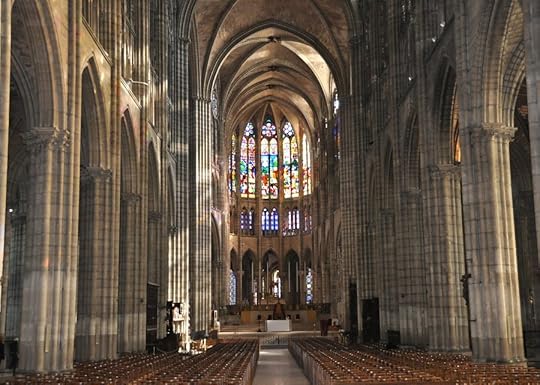
Often cited as the birthplace of Gothic architecture, the Abbey of Saint-Denis, just outside Paris, was rebuilt in the 12th century under the guidance of Abbot Suger, a visionary figure deeply inspired by monastic principles. The renovation of Saint-Denis marked the transition from the Romanesque to the Gothic style, introducing the pointed arch, ribbed vaulting, and the use of stained glass windows on an unprecedented scale.
Abbot Suger’s theological beliefs, influenced by the mystical ideas of Pseudo-Dionysius, emphasized the importance of light as a symbol of the divine. This belief is manifested in the Abbey’s massive windows, which allowed light to stream into the building, transforming the interior into a luminous space of spiritual contemplation. Suger’s emphasis on light and its connection to the divine can be traced back to the meditative practices of monastic life, where quiet reflection and communion with God were paramount.
3. Cistercian Abbey of Clairvaux
Founded by the reformist monk Saint Bernard of Clairvaux in 1115, the Abbey of Clairvaux exemplifies the Cistercian approach to architecture. Saint Bernard was a vocal critic of the ornamental excesses he saw in other monastic buildings, particularly Cluniac abbeys, which he felt distracted from the true purpose of religious life.
The architecture of Clairvaux, like other Cistercian monasteries, reflected a commitment to austerity and functionality. The abbey’s buildings were designed with clarity and simplicity in mind, avoiding the ornate sculptures and carvings typical of other Gothic structures. However, the fundamental principles of Gothic architecture—light, height, and space—were still evident, albeit in a more restrained form.
The Cistercians’ preference for simplicity over excessive decoration influenced broader Gothic architectural trends, encouraging a focus on clean lines, structural integrity, and the symbolic use of light.
Spiritual and Aesthetic Principles Behind Gothic Monastic ArchitectureMonastic influence on Gothic architecture was not purely aesthetic but deeply rooted in the spiritual goals of these religious communities. For monastic orders, architecture was an expression of devotion, designed to create a space where the soul could ascend toward God. Several key spiritual and aesthetic principles guided the development of Gothic architecture, particularly in monastic settings:
Light as a Symbol of the Divine: Stained glass windows and large openings allowed for the play of light within sacred spaces. In monastic buildings, light was seen as a metaphor for God’s presence, and this belief shaped the design of large windows and the open, soaring spaces found in Gothic churches.Simplicity and Purity: The Cistercian order, in particular, championed simplicity as a reflection of spiritual purity. Their buildings emphasized clear, unadorned spaces that fostered contemplation, rejecting the material excess they felt distanced worshippers from true spirituality.Harmony and Proportion: Monastic architects embraced the idea of sacred geometry, where proportions in design reflected the order of God’s creation. The harmonious layout of cathedrals, with their towering spires and precise symmetry, was intended to reflect the divine order of the universe.Functionality as Spiritual Discipline: Monastic architecture was highly functional, designed to serve the needs of the monastic community, whether it was for prayer, work, or communal living. However, this functionality was also symbolic, embodying the disciplined and focused nature of monastic life.Conclusion: The Lasting Impact of the Gothic on European ArchitectureThe monastic orders of the medieval period left an indelible mark on Gothic architecture, helping to shape some of Europe’s most iconic buildings. Through their commitment to simplicity, spiritual contemplation, and architectural innovation, orders like the Cistercians played a central role in defining the aesthetic and philosophical character of Gothic design. From the towering cathedrals of France to the austere abbeys of the Cistercian order, monastic principles continue to resonate in the architectural legacy of medieval Europe, a testament to the enduring connection between faith, art, and architecture.
September 27, 2024
Singles: When Grunge Went to College

I remember very precisely when I was sitting in the Commons at University of Florida in late 1991 and listened to Nirvana’s Nevermind for the first time and was blown away. However, I didn’t really tie it to a vibrant music scene in Seattle until seeing the movie “Singles” later in 1992 at which time I became somewhat obsessed with grunge and that obsession has never really died since. This article is about the history of Seattle music around the late 80s and early 90s, how cinema changed our perception of it, and how it changed as a result.
Say Anything
When Microsoft moved to Seattle in 1986 creating a silicon revolution for Boeing city, it was a rather quite event at the time. Seattle was known by true music fans as the once birthhome to the astounding Jimi Hendrix, but Jimi’s trajectory took him very early far from his northwest routes and Seattle sunk back into music oblivion.
The movie “Say Anything” came out in 1989 and suddenly Seattle was back in the public spotlight. A relatively small success of a film, it was mostly a John Cusack vehicle and Cameron Crowe’s directoral debut. The soundtrack was excellent featuring some bands that got early boosts (Living Color, Red Hot Chili Peppers, The Replacements, Fishbone) and some veterans (Depeche Mode, Nancy Wilson, Peter Gabriel), but ironically, none of these bands were from Seattle.

In the background and relatively far from the public eye, the grunge scene was taking off in the wet, slick streets and clubs of Seattle’s night scene. Bands like Mudhoney, Soundgarden, and Green River were already forging new sounds based on a loose mashup of classic rock, punk, and metal. Mother Love Bone featured the gorgeous voice of the young Andy Wood as well as the core of Green River: Jeff Ament, Stone Gossard, and Bruce Fairweather. An early warning into what would be a tragic trend in the bands of this era, Andy Wood overdosed on heroin in 1990, he was 24. Ament, Gossard, and their friend and former roomate of Wood, Chris Cornell of Soundgarden as well as Soundgarden’s drummer Matt Cameron came together for a one-off project called Temple of the Dog to honor their friend’s passing.

The immediate result of this collaboration was for formation of Pearl Jam with the addition of Eddie Vedder (from LA, not Seattle) who sang with Chris on the epic song “Hunger Strike” on the Temple of the Dog project as well as Mike McCready.
Nirvana
For me 1991 was one of rock-n-roll’s more epic years with albums as diverse as Metallica and U2’s Achtung Baby as well as Blood Sugar Sex Magic by the Red Hot Chili Peppers. But what really happened in 1991 was the explosion of music from Seattle: Pearl Jam’s Ten started the ball early, Badmotorfinger by Soundgarden, Uncle Anaesthesia by Screaming Trees, the previously mentioned Temple of the Dog tribute album, Pretty on the Inside by Hole, and Every Good Boy Deserves Fudge by Mudhoney, but it was really Nevermind by the trio of Kurt, David, and Krist that set the tone. Kurt’s acid vocals, his screachy guitar, David’s relentless drum attack, and Krist’s solid bassline burn down the house on this incredible album.
So much as been written about Kurt and about Nirvana, that I don’t want to rehash it all here. I will just say that the “Heck” movie about Kurt is an extraordinarily honest look at his life and I would further recommend the episode “Subterreanean” from the Foo Fighter’s HBO series Sonic Highway as it is one of the rare times that David Grohl speaks about the Nirvana years and their aftermath in his life.
Most grunge music dealt with themes of teen angst and drug addiction (particularly in Alice in Chains and Soundgarden) as well as child abuse (Pearl Jam). Nirvana’s Nevermind dealt with these in perhaps an even more visceral and raw manner over Kurt’s screaming vocals and soaring guitar licks.
Needless to say, after this album was released in September 1991, it became an immediate bombshell exploding the music market, rocketing Nirvana to millionnaire status. Kurt’s fragile psychology (and his failure to definitively quit heroin) inevitably resulted in his depressing suicide two years later, but let’s look now at the movie at the center of this article.
Singles
Cameron Crowe’s directed his second film Singles that came out in June 1992. Featuring an all-star cast including Bridget Fonda, Matt Dillon, and Bill Pullman, it was a more complex plot than Say Anything, but more importantly, it was more rooted in Seattle. The characters go to concerts of Soundgarden and Alice In Chains, visit Jimi Hendrix grave, and visit many now epic locations in Seattle. In other words, Seattle itself is a character in the film.

More importantly however, the soundtrack was almost entirely Seattle (with the exception of Minneapolis-native Paul Westerberg). In grad school, I got this album and was mesmerized by the music because it was a much more complete and diverse view of the Seattle grunge scene than just the songs that had made college radio in distant Florida (primarily Nirvana and Pearl Jam but also a few songs from Soundgarden and Alice in Chains.
The movie itself has a more existential feel in searching for meaning than Say Anything, and I felt that it showed grunge trying to grow out of its more adolescent origins into a bigger statement for Generation X. The book Generation X by Douglas Coupland had come out in March 1991, but I think I discovered it about this same period of 1992 and it put names on many of the raw emotions that grunge tried to express.
The problem however was heroin. So many people died from this generation, Andy and Kurt early on, but Layne Staley, Mike Starr (both of Alice in Chains), Chris Cornell later, and this seemed to take a lot of wind out of the sails of grunge music. There were grunge wannabes like Stone Temple Pilots who also suffered the addictions and early deaths of their band members (Scott Weiland and Scott Bennington). Maybe it was just too dark, I dunno. But there was an undercurrent to the grunge scene that washed away in the wake of all these deaths.
Conclusion
I personally am glad that grunge came about when it did and I still mourn for the many deaths that occured over the years. I feel like the angst they expressed is still there, but has kind of morphed into the famous standoffishness of the millennials, the inheritors of grunge culture as they drink their Starbucks lattes and get their noses pierced. Will there ever be another rebirth of rock-n-roll as violent and poignant as that chronicled by the Singles soundtrack and exemplified by the many albums that came out of Seattle in 1991?
September 24, 2024
From Constantine to Romanesque: The Foundations of Christian Architecture
 Saint-Jacques de Compostelle Church – Example of Romanesque Architecture
Saint-Jacques de Compostelle Church – Example of Romanesque ArchitectureThe history of Christian architecture is a fascinating journey that mirrors the evolution of Western civilization itself. From humble beginnings in secret worship spaces to the grand, fortified churches of the Romanesque period, the architecture of the Christian Church reflects the changing needs, beliefs, and technological advances of the societies it served. This article explores how Christian architecture transitioned from early basilicas to the monumental Romanesque structures that dominated Europe before the advent of Gothic architecture. Each sub-period not only reveals developments in form and structure but also reflects the shifting priorities of Christian worship.
Introduction: Christianity’s Rise in the Roman Empire
In 313 AD, Emperor Constantine issued the Edict of Milan, legalizing Christianity throughout the Roman Empire. This marked a turning point not only for the Christian faith but also for its architectural needs. No longer confined to private homes or secret worship spaces, Christians could now build churches that would serve as prominent places of worship and community gathering. However, without an established architectural style, early Christians adopted and adapted existing Roman civic structures, particularly the basilica.
Key Characteristics of Early Christian BasilicasForm: Based on Roman public halls, these basilicas were rectangular with a central nave flanked by aisles.Functionality: Designed for congregational worship, these early basilicas had simple designs with no significant verticality.Symbolism: The long nave symbolized the pathway to salvation, while the apse (where the altar was located) represented the heavenly realm.Example: Old St. Peter’s Basilica, Rome (c. 319 AD)

One of the most important early Christian basilicas was Old St. Peter’s Basilica, commissioned by Constantine himself. Situated on the supposed burial site of St. Peter, this basilica was designed to house the growing Christian community and served as a model for future churches. Though simple in design compared to later structures, its immense size (about 350 feet long) and spiritual significance cemented its place in Christian history. The building’s form—a wide central nave with side aisles and a clerestory to admit light—became the blueprint for early Christian architecture.
Byzantine Influence and the Eastern ChurchWhile Christianity was solidifying its architectural language in the West, a different influence was taking shape in the Eastern Roman Empire, particularly after the division between the Eastern and Western Churches. Centered in Constantinople, the Byzantine Church developed a unique architectural style that emphasized verticality, domes, and intricate mosaics.
Key Characteristics of Byzantine Architecture
Centralized Plans: Unlike the longitudinal basilicas of the West, Byzantine churches often had a centralized layout with a dominant dome, symbolizing heaven.Domes: The Byzantine innovation of placing a large, central dome on a square base (using pendentives) allowed for grand, open interior spaces.Mosaics: Interiors were lavishly decorated with mosaics depicting religious scenes, intended to inspire contemplation of the divine.Example: Hagia Sophia, Constantinople (c. 537 AD)

Commissioned by Emperor Justinian I, the Hagia Sophia stands as a masterpiece of Byzantine architecture. Its massive central dome, 100 feet in diameter and 180 feet high, appears to float above the worship space, filling the interior with light. The combination of engineering ingenuity and spiritual intent created a structure that was both a symbol of imperial power and divine authority. Hagia Sophia influenced Christian architecture for centuries and was regarded as the greatest church in Christendom until the construction of St. Peter’s Basilica in the 16th century.
The Split of East and West: Diverging PathsThe formal division between the Eastern Orthodox Church and the Roman Catholic Church in 1054 (the Great Schism) not only split Christianity but also solidified distinct architectural traditions. The Byzantine East continued its emphasis on domes and mosaics, while the West began to develop its own architectural language that would eventually lead to Romanesque and Gothic styles.
The Rise of Romanesque ArchitectureAs Europe stabilized in the aftermath of the collapse of the Western Roman Empire, a new architectural style emerged in the 10th and 11th centuries: Romanesque. The Romanesque period saw the construction of massive, fortress-like churches and cathedrals that reflected both the growing power of the Church and the need for protection in a still-volatile world. The style is called “Romanesque” because it relied on elements from Roman architecture, particularly the round arch and barrel vault.
Key Characteristics of Romanesque ArchitectureThick Walls and Heavy Construction: Romanesque churches were solid, with thick walls to support stone roofs and to protect against external threats.Barrel Vaults and Rounded Arches: Borrowed from Roman engineering, these features created a heavy, enclosed feeling inside the church.Limited Windows: Due to the structural limitations of the barrel vault, Romanesque buildings had small windows, resulting in darker interiors.Sculptural Decoration: While interior spaces were dark, exteriors were richly decorated with stone carvings, often depicting biblical scenes and moral lessons.Example: Abbey Church of Sainte-Foy, Conques (c. 1050-1130 AD)

A quintessential Romanesque structure, the Abbey Church of Sainte-Foy in France, was built to accommodate pilgrims traveling along the Camino de Santiago. Its massive stone structure, rounded arches, and small windows are typical of the Romanesque style. Particularly notable is its large tympanum above the main entrance, depicting the Last Judgment, a common theme in Romanesque church decoration intended to remind the faithful of the consequences of sin and the rewards of salvation.
Example: Durham Cathedral, England (c. 1093-1133 AD)

Durham Cathedral is one of the finest examples of Norman Romanesque architecture in England. Its massive, rib-vaulted ceilings and thick, towering piers represent the Romanesque emphasis on strength and solidity. However, Durham also foreshadows the coming Gothic innovations, as it was one of the first cathedrals to experiment with pointed arches, a key feature of the later Gothic style.
By the late 11th century, the limitations of Romanesque architecture began to frustrate architects and religious leaders. The thick walls and barrel vaults, while solid, allowed for only small windows and dark interiors—hardly conducive to the Church’s desire to fill their worship spaces with the light of God. Additionally, Romanesque buildings, though grand, lacked the verticality that later architects would use to inspire a sense of divine transcendence. This need for greater height and light led to the development of Gothic architecture.
Key Innovations that Led to the Gothic StylePointed Arches: By distributing weight more efficiently, pointed arches allowed for taller buildings and wider, more open interiors.Ribbed Vaults: A refinement of the barrel vault, ribbed vaults provided greater structural support while reducing the need for massive walls.Flying Buttresses: This external support system enabled architects to construct taller walls with larger windows, revolutionizing the interior light of churches.Example: Saint-Étienne, Caen (c. 1063-1130 AD)
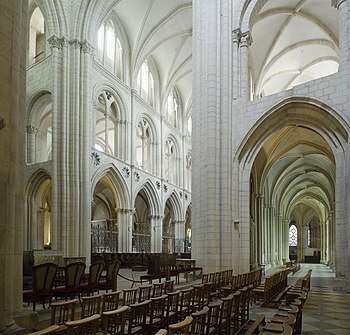
The Abbey of Saint-Étienne in Normandy was one of the first major Romanesque churches to experiment with ribbed vaulting and pointed arches, both of which became key elements of the Gothic style. While still Romanesque in its thick walls and relatively modest windows, Saint-Étienne represented the transition between the two architectural periods, laying the groundwork for the soaring heights and luminosity of Gothic cathedrals.
Conclusion: From Roman to Romanesque, and BeyondThe evolution of Christian architecture from the early basilicas of Constantine’s era to the monumental Romanesque churches of the 11th century reveals a continuous search for greater expression of faith through building design. Each architectural period—from the early, simple basilicas to the domed grandeur of Byzantine churches to the fortified Romanesque churches—responded to the needs and circumstances of its time. Romanesque architecture, with its weighty construction and dark interiors, was monumental in scope but limited in expression. The transition to Gothic architecture, marked by engineering innovations like pointed arches, ribbed vaults, and flying buttresses, allowed for buildings that were both structurally innovative and spiritually uplifting. In this context, the Gothic cathedrals that followed represent not just an architectural shift but a culmination of centuries of Christian architectural experimentation.
September 20, 2024
Foundations of Faith: Monastic Orders and Their Influence on Medieval Art and Architecture
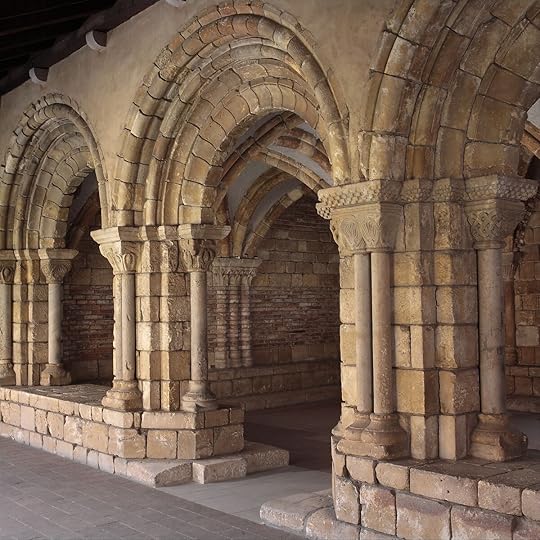
Introduction: Welcome to the Artful Mind Blog’s Inaugural Post
Throughout the Middle Ages, monastic orders played a pivotal role in shaping the spiritual and cultural landscape of Western Europe. As centers of prayer, learning, and community, these religious institutions were not only the custodians of Christian faith but also the patrons and innovators of artistic and architectural traditions that continue to inspire to this day. In this inaugural episode of Artful Mind, we explore how the Benedictines, Cistercians, Franciscans, and Dominicans—each with their distinct spiritual philosophies—left an indelible mark on the arts, transforming the very fabric of medieval society. Future posts will talk about how each of these movements impacted architecture, painting, and sculpture as well as look outside of Europe to see how monastic orders in non-Christian religions impacted art in Asia.
Benedictines: The Architects of Order and DevotionThe Benedictine Order, founded by St. Benedict of Nursia (480-547) in the 6th century near Rome, is often considered the cornerstone of Western monasticism. Guided by the Rule of St. Benedict, which emphasized stability, manual labor, and prayer, Benedictine monasteries became self-sufficient communities dedicated to spiritual and intellectual pursuits. This focus on community and worship found expression in their architectural designs, which prioritized functionality, harmony, and a sense of divine order.

Benedictine monasteries, such as the famed Abbey of Monte Cassino (destroyed by Allied bombing in WWII but rebuilt ater the war), became models of Romanesque architecture. Characterized by solid, heavy forms, thick walls, and rounded arches, Romanesque architecture reflected the Benedictines’ values of permanence and resilience. These structures were designed not only to withstand the ravages of time but also to symbolize the eternal nature of divine truth. The simplicity and grandeur of these buildings created a sacred space that facilitated the monks’ daily rhythm of work and prayer, embodying their commitment to a life of contemplation and service. This was the dominant architectural style for churches and cathedrals built in Europe between the 6th and 13th centuries. Some famous examples of Romanesque architecture include the Pisa Cathedral (Italy), the Basilica of Saint-Sernin (Toulouse, France), and the Basilica of Cluny (France).
Cistercians: Embracing Austerity and Architectural InnovationIn the 11th century, the Cistercian Order emerged as a reform movement within Benedictine monasticism, advocating for a return to the original simplicity and austerity of monastic life. Founded by St. Robert of Molesme (1028-1111) and popularized by St. Bernard of Clairvaux (1090-1153), the Cistercians originated in eastern France and sought to eliminate the excesses that had crept into monastic life, including the lavish decorations and ornate designs of some Benedictine churches. Curiously enough, St Bernard also co-founded the Knights Templar.
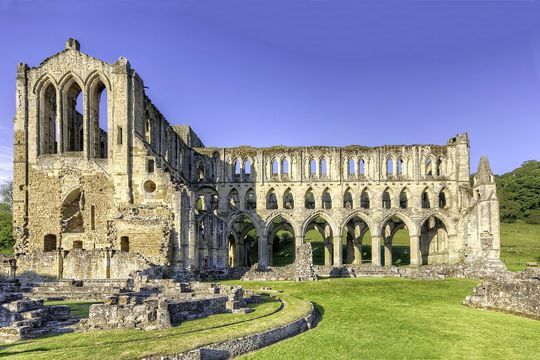
The Cistercian approach to architecture was revolutionary in its simplicity. Their churches, such as the Abbey of Fontenay (near Montbard in Burgundy, France), eschewed the elaborate ornamentation of the Romanesque style in favor of unadorned, clean lines and an emphasis on light. The use of pointed arches and ribbed vaults in Cistercian buildings would later influence the development of the Gothic style, which combined structural innovation with an ethereal quality that sought to draw the eye—and the spirit—upward, towards the heavens. The Cistercians’ commitment to functional beauty not only reflected their spiritual ideals but also laid the groundwork for the architectural marvels of the Gothic era.
Franciscans and Dominicans: The Art of Preaching Through Image and WordWhile the Benedictines and Cistercians focused on the monastic life, the Franciscans and Dominicans took their faith to the streets, founding mendicant orders that emphasized preaching, teaching, and living among the people. Established in the early 13th century by St. Francis of Assisi and St. Dominic, respectively, these orders brought a new dynamism to the Church’s mission, one that was deeply engaged with the urban centers of medieval Europe.

The Franciscans, inspired by the love of St. Francis of Assisi (1181-1226) for nature and simplicity, often commissioned art that reflected their values of humility, compassion, and the beauty of creation. This is evident in the frescoes of Giotto in the Basilica of St. Francis in Assisi (near Perugia in central Italy), where the life of St. Francis is depicted with a revolutionary use of naturalism and emotional depth. These works broke away from the more rigid, hierarchical styles of earlier medieval art, making religious themes more accessible and emotionally resonant for the faithful.

The Dominicans, on the other hand, were instrumental in the development of the Gothic style, particularly in their adoption of the large, open spaces of Gothic churches that were ideal for preaching to large congregations. Saint Dominic (1170-1221) came from north central Spain, but founded his order in 1215 in Toulouse, France. Their commitment to education and the dissemination of theological knowledge also led to the production of richly illustrated manuscripts and theological treatises that blended artistry with intellectual rigor. They often ressemble fortresses which is logical in that the Jesuits “soldiers of Christ” issued primarily from the Dominican order.
Legacy and Influence: A Living TraditionThe influence of these monastic orders on art and architecture extends far beyond the Middle Ages. Their commitment to integrating faith and beauty continues to inspire modern artists and architects who seek to create spaces that uplift the human spirit. From the minimalist aesthetics of modern church designs that echo Cistercian simplicity to contemporary artworks that draw on Franciscan themes of nature and compassion, the legacy of these early monastic orders remains vibrant and relevant.
As we journey through the Artful Mind series, we’ll continue to uncover how these foundational elements of faith have shaped the artistic and architectural traditions of the West, revealing the deep and enduring connection between spirituality and creativity. Whether in the soaring arches of a Gothic cathedral or the quiet beauty of a monastic cloister, the echoes of these monastic orders can still be felt, reminding us of the profound impact that faith can have on the world of art.
March 9, 2022
The Batman (2022) – Fino no-spoiler review

I felt that Matt Reeve’s The Batman was a great superhero flick. Comparing it to the MCU, it is slower-paced, features better photography, and my ears weren’t ringing at the end because the score and sound effects were perfect. Comparing it to other DC films, it continues the more weighty emotional trend of those films, but with darker sets and a grittier lens.
I must also compare it to the previous Batman franchise films. I think the only actor that comes close to Pattison’s superb performance was Christian Bale, but I have to say that Pattison shows even more depth and had a more interesting emotional core. His relationship with Selena is far better portrayed than the more platonic and less believable one of Bale’s Wayne with Rachel Dawes. There is really no comparison: the Batman/Selena combo is truly magical and profound.
As for the bad guys, as good as Paul Dano’s Riddler was, Heath Ledger’s Joker is still far and beyond a more terrifying and screen-enveloping character. That being said, Colin Farrell’s Penguin and John Turturro’s Falcone were the best portrayals yet of those two Gotham staples.
What sets this film apart, I think, is the Gotham in which we are immersed and never leave (no fighting in Hong Kong this time!) It is gritty and seething and utterly corrupt – more so than Nolan’s version. And I really liked the idea of reaching back to the origins of Batman in Detective Comics because we have a real mystery to work out, a crime (many crimes) to solve and Vengeance is on the trail.
Andy Sarkis’ Alfred wasn’t quite as endearing as Michael Caine’s, but the Batcave was still cool and his gear, less fancy but cool nonetheless. I do miss Nolan’s Batmobile with the Big Wheel tires, but the Mustang-inspired one here was still badass.
The soundtrack featuring a cover of Something in the Way by Nirvana is truly excellent. I will have to see it again to search for more Easter eggs of the same sort, but the camera shot towards the end which was very obviously inspired by Edward Hopper’s iconic Nighthawks painting was gorgeous. I have to say it again, this has to be the best cinematography ever in either the DC catalog or the MCU.
4.5/5.0
March 6, 2022
Pulitzer 2022 Reading Update!
I am still reading lots of books trying to guess who might win this year’s Pulitzer. My list so far:
1. The Five Wounds by Kirstin Valdez Quade – The Pulitzer has never gone to a Latina, will this be the year? In fact, only Latinos that ever won here Oscar Hijuelos in 1990 for Mambo Kings and Junot Diaz for Oscar Wao, so perhaps a Mexican-American debut novel would be a fantastic choice?
2. The Lincoln Highway by Amor Towles – This is an excellent book, but honestly I preferred A Gentleman in Moscow which I think got ripped off in 2017 when an inferior Underground Railroad won instead. This one is great regardless.
3. Zorrie by Laird Hunt – this was a poetic life story about the Great Depression in the midwest seen through the eyes of a woman in Indiana who goes through a Willa Cather-style set of challenges and growth spurts. The prose is beautiful and measured without being overbearing or overly sentimental. It is a book which you will not soon forget.
4. Hell of a Book by Jason Mott – Funny, thought-provoking and powerful, this book surprised me and underlined many of the reasons why I respect Enimem’s kneel at the halftime show. ‘Nuf said. It was indeed a helluva book!
5. My Monticello by Jocelyn Nicole Johnson – a great little collection of short stories, the best of which is the eponymous final one about a speculative ending to the Charlottesville violence during the first year of TFG.
6. My Year Abroad by Chang-rae Lee – while this is not as strong a book as The Surrendered, it is better than On Such a Full Sea or Native Speaker. One thing for sure, Chang-rae Lee does NOT stick to any one genre for very long. This book reminded me of the best parts of The Goldfinch. Probably not a Pulitzer winner, but a fun and interesting read.
7. Black Buck by Mateo Askaripour – this book’s tone and sense of biting irony reminded me a lot of Paul Beatty’s excellent (and alas un-Pulitzered) The Sellout. It talks about racism and counter-racism in terms of the vicious world of sales. Very, very entertaining.
8. The Love Songs of W.E.B. Dubois by Honorée Fanonne Jeffers – this is a coming of age book which also explores the issue of skin tone and racism in academia so in a sense it reminded me of the poetry of Tar Baby by Toni Morrison and The Human Stain by Philip Roth. It is a long, but beautiful read.
9. The Committed by Viet Thanh Nguyen – the sequel to 2016 winning The Sympathizer is another fun first-person ride into the Vietnamese psyche with all its complexities and contradictions but taking place in my own Paris of the 70s. A great read, but probably not worthy of a second PP.
10. The Prophets by Robert Jones Jr. – this was an interesting book about slavery with a gay slave couple. Well-written, but not nearly as powerful as, say, Beloved by Toni Morrison (Pulitzer 1987, Nobel Prize 1993) or as detailed as Roots by Alex Haley. A gripping tale, but not a perfect one.
11. Libertie by Kaitlyn Greenridge – an interesting tale taking place in New Jersey post-Civil War and later in Haïti, it tells the fictionalized story of the first black female surgeon in the states, but takes a few twists and turns and maybe loses some readers along the way.
12. Foregone by Russell Banks – I haven’t read his Pulitzer-runnerup Cloudsplitter yet, but this one did not blow me away. The deathbed confessions of this documentary filmmaker intended to come clean to his soon-to-be widow reads as overwritten (using a $5 word when a nickel word would do) and just isn’t that entertaining.
13. Oh William! by Elizabeth Strout – this could arguably be higher up in the list because I actually enjoyed it more than her Pulitzer-winning Olive Kitteridge (2009), but I am just not a huge fan of Strout’s writing. We get the love story of a widow and her ex-husband and it has its moments, but maybe I need to read this again when I reread Rabbit at Rest or another geriatric novel of this sort.
14. Bewilderment by Richard Powers – the followup to his excellent Pulitzer winner The Overstory (2019), this is another ecological fairy tale, but less violent. Similar to The Bear by Andrew Krivak, it is a father-son post-apocalypse story with some beauty, but it nonetheless left me wanting.
15. Infinite Country by Patricia Engel – this is a well-written but very, very depressing book about Columbian refugees which reminded me somewhat of The Mambo Kings Play the Songs of Love by Oscar Hijuelos (Pulitzer 1990), because of the undeserved sympathy the author tries to make us feel for an undeserving male protagonist. I think that the work of Edwige Dandicott and Valerie Luiselli to which this is often compared is superior. There is possibly also a comparison that could be made to the über-popular American Dirt by Jeannine Cummins, but personally, I was as disappointed by that one as by this one.
16. The War for Gloria by Atticus Lish – I really did not like this coming-of-age book with characters that were each creepier and less likable than the others. I never built any sympathy for the protagonist or his awful mom or terrifying stepdad and I felt the novel left way too many questions unanswered. It was a stultifyingly frustrating book.
17. The Archivist by Rex Pickett – I really loved the movie Sideways and assumed it was based on a great book, so I thought I’d give this one a shot by its author. Pretentious, overbearing, and hopelessly ignorant of computers, it tries to build suspense on some rather flimsy intrigue and uses some lame sex scenes to cobble together a sensual aspect to the plot. Not great.
18. Harlem Shuffle by Colson Whitehead – it probably is not fair to this ok book by double whammy Pulitzer winner (Underground Railroad 2017 and The Nickel Boys 2020), but the story just wasn’t tall that well put together. There is an interesting but not passionate depiction of Harlem and New York in the late 50s early 60s, but the characters just were not all that interesting and I felt that there were some things that were just off in the book. Probably not a triple crown winner.
19. Abundance by Jakob Guanzon – depression central, this book has an original structure naming chapters by the net worth of its loser protagonist, but it loses the reader with all the time shifts and the extremely unlikable characters throughout. It was like watching a cheapo paperback about Badger and Skinny Pete from Breaking Bad who had an unfortunate kid they drug around. Just, too depressing and not that well written.
20. Harrow by Joy Williams – and very last, this awful little apocalyptic mess. No plot, no characters, no sense in this weird, colorless world. I could not wait to get this one out of my head because I felt it was just awful and poorly written.
Still on my Pulitzer 2022 TBR in order of likelihood to read:
– Late City by Pulitzer Laureate (1993) Robert Olen Butler
– The Book of Emptiness Form and Emptiness by Ruth Ozeki
– Crossroads by Jonathan Franzen
– The Sentence by Pulitzer Laureate (2020) Louise Erdrich
– Razorblade Tears by S.A. Cosby
– Our Country Friends by Gary Shteyngart
– Clock Cuckoo Land by Pulitzer Laureate (2015) Anthony Doerr
– Appleseed by Matt Bell
– Matrix by Lauren Goff
– Rovers by Richard Lange
– Great Circle by Maggie Shipstead
– A Calling for Charlies Barnes by Joshua Ferris
– Whereabouts by Pulitzer Laureate (2000) Jhumpa Lahiri
– Mercy Street by Jennifer Haigh
– The Paper Palace by Miranda Cowley Heller
– Fugitives of the Heart (posthumous) by William Gay
– Morningside Heights by Joshua Henkin
– The Mysteries by Marisa Solver
– The Night Always Comes by Willy Vlautin
– Secrets of Happiness by Joan Silber
– Intimacies by Katie Kitamura
– How Beautiful We Were by Imbolo Mbue
– No One Is Talking About This by Patricia Lockwood
– Wayward by Dana Spiotta
– The Days of Afrekete by Asali Solomon
– Five Tuesdays in Winter by Lily King
Vote for your favorites here: https://www.goodreads.com/list/show/171938.2022_Pulitzer_for_Fiction_Who_will_win_
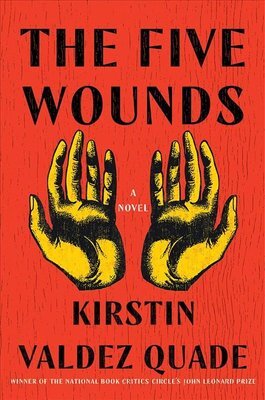
January 16, 2022
Pulitzer Prize – not always the best arbiter of literary excellence
I found that the Pulitzer committee often overlooked excellent books and awarded lacklustre ones. Here is my Top 10 list of books which I felt were absolutely not Pulitzer-worthy.
Scarlet Sister Mary by Julia Peterkin (1929) was just a disaster cover to cover. Why the committee would award this book of racist stereotypes about black women by a white woman just boggles my mind. Granted, 1928 was rather weak in terms of novels with no output from Hemingway, Cather, Faulkner, or Fitzgerald, there was not another clear choice. But there was a precedent for no prize being given (1920), so why award something so derivative and corny? I truly did not understand this one.Laughing Boy by Oliver La Farge (1930) was just as bad in terms of stereotypical depiction of sensual, unintelligent American Indians and its choice baffles me. Particularly in light of the fact that the monumental The Sound and the Fury by Faulkner was published the same year and was an astounding work of art. Why Faulkner had to wait until 1955 (!) for a relatively inferior novel (A Fable) and after already having won a Nobel Prize for Literature in 1949, well, it is just hard to comprehend in retrospect.All the Light We Cannot See by Anthony Doerr (2015) absolutely underwhelmed me. I felt that the tropes (blind French girl meets “nice” German soldier malgré-lui) were overwrought and annoying. The characters did nothing to really draw me into the narrative which I found stiff and predictable. Lila by Marilynne Robinson, Station 11 by Emily St John Mandel, and Euphoria by Lily King were all better and more original books. This one just seemed begging Spielberg to turn his post-Schindler’s list scriptwriters over to Doerr for a new film. The Nickel Boys by Colson Whitehead (2020) was also a disappointing choice. I enjoyed Whitehead’s earlier fiction (especially The Colossus of New York), and only mildly liked his 2017 Pulitzer winning The Underground Railroad. I can see that in light of the US political situation, the topic of black men mistreated in Florida prisons and reform schools was very topical, but did Whitehead truly deserve to be on the tiny list of two-time Pulitzer winners with Updike, Tarkington (ok maybe him), and Faulkner (albeit as already mentioned, Faulkner should have been compensated decades before he was) when authors like Philip Roth should have been there, Toni Morrison easily deserved a second one, etc. There were other excellent books printed that year: The Dutch House by Ann Pratchett and Disappearing Earth by Julia Philips (an excellent debut novel!) both being excellent.Less by Andrew Sean Greer (2018) also disappointed me. I suppose that it was the first book by an openly gay man (unless we count Middlesex by Jeffrey Eugenides although I don’t think Eugenides has come out as either gay or trans) was overdue, but this book is just a comedic travelogue and not really that spectacular from a literary point of view. 4 3 2 1 by Paul Auster was absolutely incredible and a far more American novel than Less (and considerably better than the two runner-ups, The Idiot by Elif Bautman and In the Distance by Herman Diaz.)The Executioner’s Song by Norman Mailer (1980) was just long and, if we believe his protagonist’s brother in his autobiography, largely plagiarised from his colleagues. It is billed as the first “non-fiction novel” but really, wasn’t In Cold Blood by Truman Capote already a masterpiece in that category? The book just drags on for over 1000 pages (making it the longest Pulitzer winner on record) and spends too much time on trying to build sympathy for the murderer at the heard of the story. Roth’s Ghost Writer was a better book, but only got a runner-up that year. Just Above My Head by James Baldwin would also have been a better choice, but perhaps they thought that the lacklustre award to McPherson in 1978 for Elbow Room fulfilled their African-American quota. As for Jewish writers, I find that fellow Jewish laureats Bellow, Roth, Chabon, and even Malamud were all far superior to Mailer, but anyway…The Mambo Kings Play Songs of Love by Oscar Hijuelos (1990) is the ONLY Pulitzer winner of Spanish-American origin besides Junot Diaz (The Brief Wondrous Life of Oscar Wao (2008)) which is probably surprising given that the prevalence of immigrants from South and Central America in the latter half of the 20th century. I felt that the sob story of two brothers from Cuba trying to make it in New York in the 50s was just too sexist and too boisterous to be fun or even interesting reading. There is some horrific (if somewhat gratuitous) violence against women and once again, I felt no sympathy for the protagonists. Maybe Billy Bathgate by E.L. Doctorow or The Joy Luck Club by Amy Tan would have been better choices but as yet, I haven’t read them. I just did not like Mambo Kings.Tinkers by Paul Harding (2010) was so underwhelming and so tiny that I almost forgot it as I was reading it. OK, so there are clocks and stuff. And? I just did not see how this book gets the same honors as something as consequent as another tiny book but absolute masterpiece, The Old Man and the Sea by Hemingway (1953). I mean why not just go to Thomas Harris for Hannibal for that matter? At least the latter provoked some strong emotions (fear, terror) rather than the indifference engendered by Hardings short forgettable book.The Reivers by William Faulkner (1963) will shock those that know me. How could I possibly list a Faulkner in my “worst” list? Well, I would say that (1) this is one of his weakest books and only published (and awarded) posthumously as an afterthought (2) he should have won it (as already pointed out in #2 above) for The Sound and the Fury, Light in August, As I Lay Dying…and so why just try to “ratrapper le coup”? (3) there was a far better book that was more original, more revolutionary, more mind-bending that was published the same year: One Flew Over the Cuckoo’s Nest by Ken Kesey. A thrilling story made into one of the monuments of American cinema, it was shameful that the negligence of the Pulitzer committee over the 25 years of production of Faulkner before the 50s had to be paid at the expense of Kesey’s masterpiece.No award given – 1941: For Whom the Bell Tolls by Ernest Hemingway, 1946: Black Boy by Richard Wright, 1954: The Adventures of Augie March by Saul Bellow, and 1974: Gravity’s Rainbow by Thomas Pynchon. In each of these cases, the Pulitzer passed on committee recommendations and refused to grant a reward. (I’d probably add 1957 : The Voice at the Back Door by Elizabeth Spencer as well, but I haven’t read it yet). There were a few other years when no novel stuck out, but I feel that these particular novels were totally ripped off for spurious reasons. In the case of Wright, they said it was a memoir and so disqualified (but then they gave a non-fiction book the award in 1980 (see #6 above). For Hemingway and Pynchon, they claimed the books were too vulgar which just drives me crazy because the former is not vulgar at all and the second’s vulgarity concerns Nazi perverts and so seemed absolutely justifiable to me. Of all of these, I think the worst omissions were those of Augie March which is my favorite Bellow of all (and Roth’s inspiration as well) and Gravity’s Rainbow which is one of the most difficult but rewarding books I have ever read.January 11, 2022
Pondering the Pulitzer – Part 1 – Westerns!
I recently finished all of the Pulitzers and will write a few posts about some of my favorites, my least favorites, and other lists and whatnot. Being that the Pulitzer was originally intended to be about the American way of life, nothing is more American than the Western literary genre. For my first list, how about a Top 10 of Westerns in the Pulitzer winners column:
1. Lonesome Dove – Larry McMurtry (1986)
An absolute masterpiece with wonderful protagonists Gus and Call, a Homeric quest across the West from Texas to Montana, encounters with Indians…just all around one of the greatest westerns I have ever read. Gus and Call are two of the most unforgettable best friends in US literature. Of course, it would not pass muster in terms of woke or political correctness, but then what western would?
Pro Tip: Check out the TV miniseries with Robert Duvall as the lovable Gus and Tommy Lee Jones as the unperturbable Call. Fantastic!
2. Grapes of Wrath – John Steinbeck (1940)
This Dust Bowl classic takes the Joad family away from the nightmarish grey Oklahoma plains to the fabled California Dream which turns out to be anything but hopeful. Various voices are used to describe the journey (in the vein of John Dos Passos USA trilogy) and there are also the many wonderful speeches of Tom Joad and his special brand of deism. A truly magnificent read.
Pro Tip: The John Ford film with Henri Fonda as Tom Joad is one of Hollywood’s finest moments.
Pro Tip 2: Sometimes you get unlucky: Sanora Babb wrote her Dust Bowl epic Whose Names are Unknown at the same time as Steinbeck – the two most likely crossed paths and shared some notes during their research of the period – but Steinbeck beat her to the press. The publishers on Madison Ave decided that the public could only deal with one Dust Bowl story at a time and that sales of Grapes of Wrath would be hurt by another book on the same subject, so, sadly, Babb’s book was shelved. Babb got blacklisted in the 50s in the early days of the McCarthy witchhunts and the book did not get published until 2004, a year before she died in 2005. It is less visceral than Grapes, but takes a longer time than Grapes to tell the story of how things fell apart in Oklahoma – something Babb herself lived through. Worth seeking out on the Kindle.
3. The Travels of Jaimie McPheeters – Robert Lewis Taylor (1959)Sort of a far more visceral Huck Finn approach to a western, we follow our young protagonist along the Oregon Trail to the gold mines of California. A real delight but hard to find.
Pro Tip: I used archive.org for the out-of-print books on the list.
4. Now in November – Josephine Winslow Johnson (1935)
This forgotten book was a debut novel for Johnson and a beautiful invocation of life in Oregon during the famines of the 1930s. Beautifully written, it describes the difficult life of four daughters.
Pro Tip: After writing Now in November, Johnson wrote primarily poetry and short stories, for the latter of which she won O’Henry Prize 5 times.
Pro Top 2: This was the 3rd debut novel to win the Pulitzer after The Able McLaughlins (1924) – more on that one in a minute – and Years of Grace (1931) by Margaret Ayer Barnes.
5. One of Ours – Willa Cather (1923)
Cather is always a fun read. Her books bathe in a cultural smorgasbord on the midwestern frontier near Nebraska for the most part people with first-generation Germans, Norwegians, and Swedes – the environment in which Willa herself grew up. During this book, we spend half of the time with Claude in his frustrating marriage on the farm in Nebraska and then follow him to the brutal battlefields of France in 1918. In act, the structure kind of reminded me of Stanley Kubrick’s story structure in “Full Metal Jacket”.
Pro Tip: If you like this one, check out some of her other amazing books such as O Pioneers!, My Ántonia, and (admittedly still on my TBR) Death Comes for the Archbishop. Note to self: maybe do a post about Catholic books on the Pulitzer list – there were loads actually!
6. The Town – Conrad Richter (1951)
Conrad Richter wrote The Awakening Land trilogy starting with The Trees in 1940 and The Fields in 1946 (I read the former, skipped the latter), and finished it with this award-winner. It covers the life of his protagonist Sayward Wheeler and her family on the Ohio Valley frontier from the 1820s to the 1860s. It was a tough life and well-described here by Richter. It was particularly interesting to see the world transform from its “pioneer” state to a more modern civilized state with the removal of the forest and the arrival of the telegraph and the train.
Pro Tip: Actually, he nearly won the Prize for the first book in the trilogy which I actually enjoyed more than this one.
7. The Way West – A.B. Guthrie (1950)
This is also part of a series of books, The Big Sky which consists of a total of 6 books. I read the first volume – the eponymous Big Sky – and this award winner. In this book, we have another wagon train along the Oregon Trail with a crazy host of characters. It was interesting to compare the experiences in this book to those of Jaimie McPheeters.
Pro Tip: I preferred the first novel due to the epic protagonists, only one of which is present in The Way West.
Pro Tip 2: This book is one of the least politically correct on this list so caveat emptor.
8. Honey in the Horn – Harold L. Davis (1936)
The third book on this list that deals with Oregon, this one takes place between the Oregon Trail and the Dustbowl from 1906-1908. This one takes place in the wild coastal regions with a strange love triangle and some less than amazing adventures.
Pro Tip: I wasn’t sold on this one and feel that Sinclair Lewis’ It Can’t Happen Here was a more worthy book – certainly it had a longer shelflife!
9. The Able McLaughlins – Margaret Wilson (1924)I wasn’t enamored with this book about Iowa during the Civil War. There was another love triangle here like in the previous book, and it just withered on the vine for me.
Pro Tip: This was the first debut novel to win the Pulitzer and the represents with the following year, the only moment when there was the same number (3 in 1924) or more (4 in 1925) women laureates than men.
10. Laughing Boy – Olivier La Farge (1930)
This one comes dead last for me (and very low on the over the list of 101 books that won the PP) because it felt so condescending towards Amerindians. In 1915, cars arrive in the Navajo nation and change will not be happy. Yes, there is some valuable description of the lives of the Navajo, but the protagonists all never evolve intellectually beyond adolescence. They never become fully well-rounded.
Pro Tip: There is one saving grace which is that La Farge does point out the damage wrought on the Native communities by government schools. A topic that Louise Erdrich and Sherman Alexie talk about in their more contemporary books.
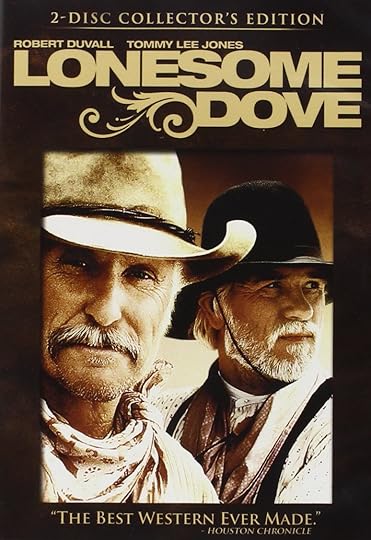
October 10, 2020
The Last 50 Years of Pulitzers (1970-2020)
I have been on a project to read all the Pulitzer winners (and some of the runner’s ups). It has been a wonderful adventure during which I have discovered authors that I would have otherwise missed, but also with some deceptions where I disagreed more or less strongly with the decision of the Pulitzer committee.
The Pulitzer was given 47 times over the last 51 years, whereas in the years of 1971, 1974, 1977, and 2012 there was no winner. In 1971 and 2012, they apparently did not think that there was a book that stood above the others; however, I would have thought Toni Morrison’s fantastic debut, The Bluest Eye could have been an appropriate choice for 1971. In 1974 and 1977 respectively, Thomas Pynchon’s magnificent Gravity’s Rainbow and Norman McLean’s A River Runs Through It were selected by the fiction jury but then rejected by the Pulitzer board who has a final decision. In 1977, they did give a special Pulitzer to Roots by Alex Haley.
Of the 47 prizes that were awarded, 30 went to men. This was a surprise as I usually thought of these prizes as being awarded primarily to men, but it was enlightening to see that a third of the prizes went to deserving women writers.
As for locations, the prize went 14 times to books that are based in New York, 7 took place in the South, 6 were collections of short stories, and 6 took place in New England, and 5 in the West. Europe and Asia were locations for 3 books each and Canada twice. I guess that if you want to win the Pulitzer, it might be a good bet to keep New York in the story somehow or at least focus on New England.
As for the time period, 24 times the period was contemporary to the author, 48 took place in the 20th/21st century, and 7 in the 19th century. Four of the books revolved around the Civil War and 3 had slavery as a theme. WWII was the background for 3 books and the Vietnam War was the background for 2 books. And there was only one novel, The Road by Cormac McCarthy was in an imaginary dystopian future.
Of the many protagonists, the ones that made the biggest impression on me were Rabbit Angstrom in Rabbit Is Rich and Rabbit At Rest, Ignatius Reilly in A Confederacy of Dunces, Theodore Decker in The Goldfinch, Seymore “Swede” Levov in American Pastoral, Joshua Chamberlain in The Killer Angels, Sethe in Beloved, Celie in The Color Purple, Quoyle in The Shipping News, and Gus and Woodrow from The Lonesome Dove. On the other hand, the protagonists I couldn’t stand included Olive Kitteridge (eponymous), Bennie Salazar in The Good Squad, Cesar Castillo in The Mambo Kings, Marie-Laure and Werner in All The Light We Cannot See, Elwood Curtis in The Nickel Boys, and Henry Townsend in The Known World.
Here are my overall rankings. My apologies, but since I strongly feel that Gravity’s Rainbow was robbed in 1974 and that it was the best book written in the past 50 years, it gets a controversial #1 ranking in my table.
RankingTitle1[Gravity’s Rainbow]2Beloved3The Goldfinch4Lonesome Dove5A Confederacy of Dunces6The Shipping News7American Pastoral8Rabbit at Rest9The Orphan Master’s Son10Independence Day11The Color Purple12The Overstory13Empire Falls14The Sympathizer15Gilead16The Amazing Adventures of Kavalier & Clay17The Road18The Stone Diaries19Humboldt’s Gift20March21A Thousand Acres22The Brief Wondrous Life of Oscar Wao23Middlesex24Angle of Repose25A Good Scent from a Strange Mountain26The Optimist’s Daughter27The Killer Angels 28Elbow Room29The Stories of John Cheever30The Executioner’s Song31Rabbit Is Rich32Ironweed33Foreign Affairs34A Summons to Memphis35Breathing Lessons36The Mambo Kings Play Songs of Love37A Visit From the Goon Squad38The Collected Stories of Jean Stafford39Martin Dressler: The Tale of an American Dreamer40Interpreter of Maladies41Olive Kitteridge42Tinkers43The Hours44The Known World45Less46The Nickel Boys47The Underground Railroad48All the Light We Cannot See
October 6, 2020
Reading Shakespeare
Several years ago, I purchased the Oxford Complete Shakespeare and placed it on my shelf. It stared at me more and more intensely, particularly during the confinement period in the spring of 2020. In a moment of existential angst, I finally gave in to its guilty looks and began reading each of the plays as well as a wealth of criticism and commentary on Shakespeare and was more than healthily rewarded for the effort.
One of the first barriers to entry for someone reading Shakespeare is the archaic language he uses. Most modern versions use emendated texts with modern spelling, but in order to preserve the iambic meter (da-Da-da-Da-da-Da-da-Da-da-Da) in most of the lines of blank verse, some conventions that the Bard used such as the “èd” at the end of verbs is kept. Admittedly, it gets some getting used to the syntax as well, but I found that after struggling through the first few plays, I found my reading rhythm and was less disturbed by the difficult grammar.
When reading Shakespeare, given the wide variety of genres and themes that he deals with, it is difficult to know where to start. I decided to begin with a chronological approach, but when I hit the 8-play history series (well, nine plays if you count the recently attributed and enjoyable Edward III) that covers Hundred Year’s War and the War of the Roses, I decided to read them in historical order and supplement this reading with Shakespeare’s Kings by John Julius Norwich. It was a good plan and a lot of fun. I would also highly recommend watching The Hollow Crown, a BBC adaptation in two series from 2012 and 2016 which covers these plays nearly line-by-line. Also, the classic Laurence Olivier versions of Richard III and Henry V as well as Kenneth Branagh’s Henry V and Richard Loncraine’s Richard III starring Ian McKellan as a particularly terrifying Richard III.
There are so many layers to Shakespeare, that it is hard as a writer to set it all down on paper. There is the action as it appears to the characters in the play whether it be a comedy, a tragedy, a romance, or an adaptation of history. Then, there is what the play was saying to Elizabethan (before Elizabeth I’s death in 1603) and Jacobean audiences (under James I until Shakespeare’s sudden retirement in 1613 and his death in 1616) because there was always a contemporary message more or less evident in the texts. Lastly, there is what the plays say to us today about ourselves, about human excellence and depravity, about good and evil. When reading Shakespeare, it is helpful to have a few guides to help one along the journey to see the clues to these various strata in the Bard’s works.
In terms of critics, I limited myself primarily to 20th and 21st century writing about Shakespeare. I, unfortunately, did not major in English, but I induce from my reading that the views on Shakespeare radically changed in the last century as a result of the sea changes that society was undergoing: the industrial revolution, social revolutions, more European wars, and the advent of psychoanalysis. My understanding is that Oxford Laureat A.C. Bradley in his Shakespearean Tragedy from 1904 changed literary criticism by using a more intertextual analysis of the four major tragedies to derive insights into the deeper psychology of Hamlet, Othello, King Lear, and Macbeth. Delivered in a series of lectures, it is an incredibly exciting and insightful read.
G. Wilson Knight wrote a series of books including the famous Wheel of Fire (1931) of “interpretive criticism” (his term) in which, admitting his debt to Bradley, he explored the mythology of Shakespeare and is equally fascinating in his insights, particularly his reading of lesser known plays such as Timon of Athens. He does an excellent job of comparing the plays by plumbing their deeper meanings through character analysis and the common themes and symbols used in the plays (storms, animals, death, hate, etc).
M.W. MacCallum’s book Shakespeare’s Roman Plays was incredibly helpful for Julius Caesar, Anthony and Cleopatra, and Coriolanus to understand how Shakespeare got these stories as they had just recently been translated from Plutarch’s Lives. Actually, Shakespeare also used Plutarch for Timon of Athens as well, but this is not covered by MacCallum. Instead, he dives deep into the three plays I mentioned to show how Shakespeare built his epic characters Brutus, Cassius, Marc Anthony, Cleopatra, and Coriolanus. It is a very good introduction to this often overlooked aspect of Shakespeare.
For the comedies, I read the rather academic R.P. Draper’s Shakespeare: The Comedies and found it interesting, but perhaps a bit too abstract. On the contrary, Hugh Richmond’s Shakespeare’s Sexual Comedy: A Mirror For Lovers was excellent and extremely insightful and a delightful read.
For the later romances, Northrop Frye’s A Natural Perspective is a classic and a must read. It looks at Pericles, Cymbeline, A Winter’s Tale, and The Tempest showing how Shakespeare’s vision had matured at this point and how central a role nature plays in these late works.
Besides Norwich’s Shakespeare’s Kings and MacCallum’s Shakespeare’s Roman Plays, I also read the recent Tyrant: Shakespeare on Politics by Stephen Greenblatt. It was a vitriolic study of the various tyrants in the history plays and tragedies with a not so subtle warning about current politics and the virage in today’s world towards authoritarianism. It serves as further proof as to what I said earlier about Shakespeare’s relevance regardless of which time period he is read.
As for the plays themselves, I reviewed most of them on Goodreads and will add a list here connecting to those reviews. In the meantime, my favorites in order:
The Tempest (Miranda!)Hamlet (Ophelia!)As You Like It (totally in love with Rosalind!)Macbeth (Lady Macbeth!)King Lear (Cordelia)Midsummer Night’s Dream (Helena)Richard IIIAntony and CleopatraRichard II Henry VOthelloA Winter’s TaleJulius CaesarPericlesMuch Ado About NothingTwelfth NightThe Taming of the ShrewRomeo and Juliet1 Henry IV2 Henry IV3 Henry IVTwo Gentleman of VeronaThe Merchant of VeniceMeasure for MeasureAll’s Well That Ends WellCoriolanusCymbellineTroilus and CressidaTimon of AthensEdward III1 Henry IV2 Henry IVThe Merry Wives of WindsorTitus AndronicusLove’s Labor LostKing JohnHenry VIIITwo Noble Kinsman



